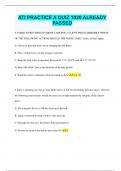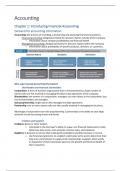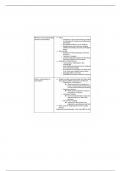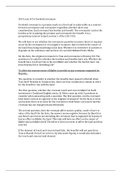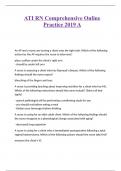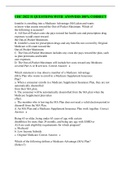Summary Infectious agents & immunity
Index
Overview lectures.......................................................................................................................................... 2
Viruses.......................................................................................................................................................... 2
Parasites........................................................................................................................................................ 4
Bacteria......................................................................................................................................................... 7
Immune responses....................................................................................................................................... 12
Vaccination.................................................................................................................................................. 16
Covid-19...................................................................................................................................................... 18
,Summary Infectious agents & immunity
Overview lectures
1. Lecture: Introduction to the course
2. Lecture: Viruses - VIRUSES
3. Lecture: Life cycle parasites - PARASITES
4. Lecture: Emerging Viruses - VIRUSES
5. Lecture: Viral innate immune responses – VIRUSES
6. Lecture: Introduction to infections and immunity – IMMUNE RESPONSES
7. Lecture: Controlled human infections
8. Lecture: One Health - PARASITES
9. Lecture: Introduction to Bacteria - BACTERIA
10. Lecture: Mycobacterial infections and HDT - BACTERIA
11. Lecture: Microbiota - BACTERIA
12. Lecture: viral vs bacterial infections- LINK TO CLINIC
13. Lecture: wondapp – LINK TO CLINIC
14. Lecture: Immune modulation and protection – IMMUNE RESPONSES
15. Lecture: Successful innate and adaptive cellular immune responses – IMMUNE
RESPONSES
16. Web Lecture: AMR and anti-infectives (self-study assignment) - BACTERIA
17. Theme day “Vaccination”
18. Theme day “COVID-19 induced immune responses”
Viruses
Structure
o Viral genome: single or double stranded RNA or DNA
o (nucleo)capsid: a protein structure that surround the viral genome. This structure is
built by using the same type of molecule over and over again (genetic economy). The
capsid of most viruses display one of two structures:
o Helical
o Icosahedral: equivalence = all subunits interact with neighbors in an identical
manner/quasi-equivalence = bonding properties of subunits in different
structural environments are similar but not identical
o Viral matrix proteins: structural proteins that link the viral envelope with the virus
nucleocapsid (crucial role in virus assembly)
o Envelope (optional): lipid bilayer around capside containing membrane proteins
o Viral envelope glycoproteins: glycoproteins in the lipid bilayer enable binding to host
receptor and fusion with ectodomain leading to host cell entry. Virus particles are able
to experience a conformational change (metastable, not inert) as a result of
acidification in edosome or binding to an receptor
Additional virion proteins are present that alter the translation by the host by for example cap
snatching (using 5’ caps as primers for to synthesize viral mRNA) or removing 5’ caps
(ineffective ribosomal recognition of host mRNA). Furthermore there are proteins present that
drive the virus into the S-phase (by inhibiting the suppressors of the cell cycle progression)
Baltimore classification
, Summary Infectious agents & immunity
Viruses can be classified according to their relationship between viral genome and the
mRNA. Positive strand is the coding strand wheras the negative strand is the template strand;
mRNA is therefore always positive (coding):
Type Type viral genome Dependent on enzymes Enzymes derive
from
I Double stranded DNA RNA polymerase Host
II Single stranded DNA DNA polymerase Host
III Double stranded RNA RNA dependent RNA Protein within virus
polymerase
IV Single stranded [+] RNA dependent RNA RNA strand
RNA* polymerase encodes for RdRp
V Single stranded [-] RNA dependent RNA Protein within virus
RNA polymerase
VI Retrovirus (ss [+] Reverse transcriptase (cDNA), Protein within virus
RNA) DNA polymerase, intergrase
*ss [+] RNA virus can directly be used as mRNA but in order to create viral genome for the
newly synthesized viruses the mRNA also has to be replicated: [+] RNA > [-] RNA > [+]
RNA. The RdRp that is necessary for this processed is translated out of the original [+] RNA
Life cycle
1. Entry into the host cell
The entry strategies for enveloped and nonenveloped viruses differ:
Enveloped Nonenveloped
Binding of viral surface with host cell Receptor mediated endocytosis followed by
receptor/co-receptor exposes fusion pore formation to extrude its viral genome
proteins. Fusion directly with the host-cell into the cytosol
plasma membrane to release their RNA
genome and capsid protein into the cytosol
(pH independent fusion)
Binding of viral surface protein to host cell Receptor mediated endocytosis followed by
receptor leads to receptor mediated disruption of endosomal membrane (lysis)
endocytosis. The endosome acidifies leading releasing viral genome in cytosol
to explosion fusion peptides and fusion with
endosomal membrane releasing viral
genome and capsid protein into the cytosol
(acid activated fusion)
2. Disassembly of the infectious virus particle
3. Replication of the viral genome: Host provides some enzymes for DNA replication
and induction of host replication enzymes is required (cell cycle proteins)
o DNA viruses replicate in the nucleus: enabling alternative splicing (except
poxvirus)
o RNA viruses replicate in the cytoplasm: expression of the viral genes as
polyprotein or by the synthesis of one or more subgenomic mRNAs (except flu
virus) > gene expression level can be regulated per gene
o Retroviruses integrate in host genome after which RNA splicing takes place
and proteolytic processing of poly-protein in cytoplasm
4. Transcription of viral genes and synthesis of viral proteins
5. Assembly of these viral components into progeny virus particles:
Index
Overview lectures.......................................................................................................................................... 2
Viruses.......................................................................................................................................................... 2
Parasites........................................................................................................................................................ 4
Bacteria......................................................................................................................................................... 7
Immune responses....................................................................................................................................... 12
Vaccination.................................................................................................................................................. 16
Covid-19...................................................................................................................................................... 18
,Summary Infectious agents & immunity
Overview lectures
1. Lecture: Introduction to the course
2. Lecture: Viruses - VIRUSES
3. Lecture: Life cycle parasites - PARASITES
4. Lecture: Emerging Viruses - VIRUSES
5. Lecture: Viral innate immune responses – VIRUSES
6. Lecture: Introduction to infections and immunity – IMMUNE RESPONSES
7. Lecture: Controlled human infections
8. Lecture: One Health - PARASITES
9. Lecture: Introduction to Bacteria - BACTERIA
10. Lecture: Mycobacterial infections and HDT - BACTERIA
11. Lecture: Microbiota - BACTERIA
12. Lecture: viral vs bacterial infections- LINK TO CLINIC
13. Lecture: wondapp – LINK TO CLINIC
14. Lecture: Immune modulation and protection – IMMUNE RESPONSES
15. Lecture: Successful innate and adaptive cellular immune responses – IMMUNE
RESPONSES
16. Web Lecture: AMR and anti-infectives (self-study assignment) - BACTERIA
17. Theme day “Vaccination”
18. Theme day “COVID-19 induced immune responses”
Viruses
Structure
o Viral genome: single or double stranded RNA or DNA
o (nucleo)capsid: a protein structure that surround the viral genome. This structure is
built by using the same type of molecule over and over again (genetic economy). The
capsid of most viruses display one of two structures:
o Helical
o Icosahedral: equivalence = all subunits interact with neighbors in an identical
manner/quasi-equivalence = bonding properties of subunits in different
structural environments are similar but not identical
o Viral matrix proteins: structural proteins that link the viral envelope with the virus
nucleocapsid (crucial role in virus assembly)
o Envelope (optional): lipid bilayer around capside containing membrane proteins
o Viral envelope glycoproteins: glycoproteins in the lipid bilayer enable binding to host
receptor and fusion with ectodomain leading to host cell entry. Virus particles are able
to experience a conformational change (metastable, not inert) as a result of
acidification in edosome or binding to an receptor
Additional virion proteins are present that alter the translation by the host by for example cap
snatching (using 5’ caps as primers for to synthesize viral mRNA) or removing 5’ caps
(ineffective ribosomal recognition of host mRNA). Furthermore there are proteins present that
drive the virus into the S-phase (by inhibiting the suppressors of the cell cycle progression)
Baltimore classification
, Summary Infectious agents & immunity
Viruses can be classified according to their relationship between viral genome and the
mRNA. Positive strand is the coding strand wheras the negative strand is the template strand;
mRNA is therefore always positive (coding):
Type Type viral genome Dependent on enzymes Enzymes derive
from
I Double stranded DNA RNA polymerase Host
II Single stranded DNA DNA polymerase Host
III Double stranded RNA RNA dependent RNA Protein within virus
polymerase
IV Single stranded [+] RNA dependent RNA RNA strand
RNA* polymerase encodes for RdRp
V Single stranded [-] RNA dependent RNA Protein within virus
RNA polymerase
VI Retrovirus (ss [+] Reverse transcriptase (cDNA), Protein within virus
RNA) DNA polymerase, intergrase
*ss [+] RNA virus can directly be used as mRNA but in order to create viral genome for the
newly synthesized viruses the mRNA also has to be replicated: [+] RNA > [-] RNA > [+]
RNA. The RdRp that is necessary for this processed is translated out of the original [+] RNA
Life cycle
1. Entry into the host cell
The entry strategies for enveloped and nonenveloped viruses differ:
Enveloped Nonenveloped
Binding of viral surface with host cell Receptor mediated endocytosis followed by
receptor/co-receptor exposes fusion pore formation to extrude its viral genome
proteins. Fusion directly with the host-cell into the cytosol
plasma membrane to release their RNA
genome and capsid protein into the cytosol
(pH independent fusion)
Binding of viral surface protein to host cell Receptor mediated endocytosis followed by
receptor leads to receptor mediated disruption of endosomal membrane (lysis)
endocytosis. The endosome acidifies leading releasing viral genome in cytosol
to explosion fusion peptides and fusion with
endosomal membrane releasing viral
genome and capsid protein into the cytosol
(acid activated fusion)
2. Disassembly of the infectious virus particle
3. Replication of the viral genome: Host provides some enzymes for DNA replication
and induction of host replication enzymes is required (cell cycle proteins)
o DNA viruses replicate in the nucleus: enabling alternative splicing (except
poxvirus)
o RNA viruses replicate in the cytoplasm: expression of the viral genes as
polyprotein or by the synthesis of one or more subgenomic mRNAs (except flu
virus) > gene expression level can be regulated per gene
o Retroviruses integrate in host genome after which RNA splicing takes place
and proteolytic processing of poly-protein in cytoplasm
4. Transcription of viral genes and synthesis of viral proteins
5. Assembly of these viral components into progeny virus particles:


